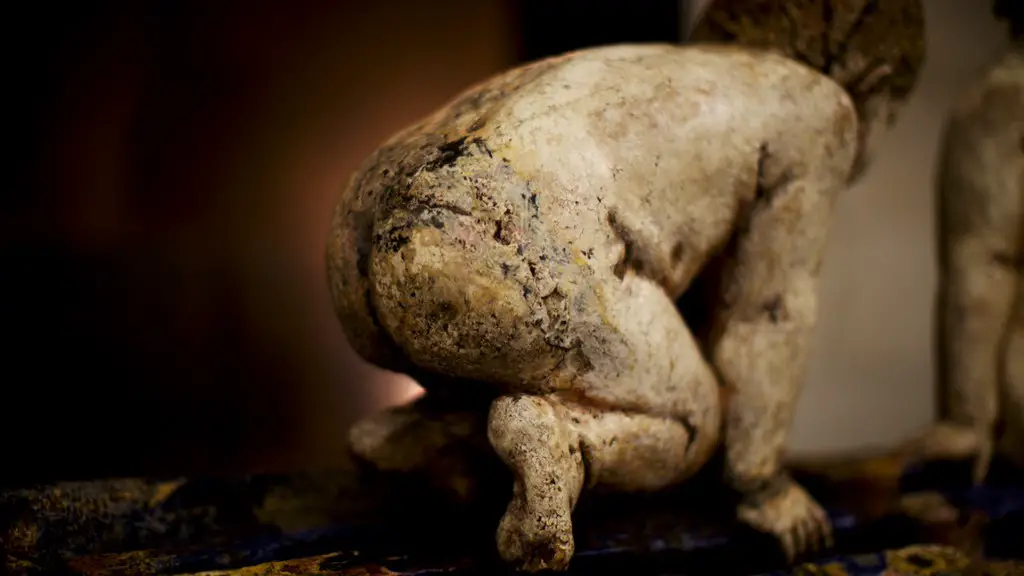A widely accepted theory is that concrete was first created by the Romans around 300 BC. Evidence from archaeological sites and artwork from the time supports this claim. For example, concrete was used to build the Temple of Jupiter Optimus Maximus on the Capitoline Hill in Rome and it appears in the Arch of Titus from AD 80.
The Roman concrete was unique because it was the first time that concrete was specifically used for the purpose of building structures. This was done by combining different materials such as aggregate, pozzolanic materials, and lime and water. Aggregate was usually a combination of sand and crushed stone, while pozzolanic materials were natural volcanic resources such as pumice or tuff. The Romans also added a mineral filler such as ground brick dust to help give added strength and durability to the concrete.
Roman engineers found that by using their own kind of concrete they could build large scale structures such as aqueducts, bridges and baths. This concrete had a high compressive strength and was able to tolerate a range of weather conditions. In comparison to modern Portland cement, Roman concrete was actually slightly less durable.
One of the most famous examples of Roman concrete architecture is the Colosseum. This iconic building was constructed in AD 72, and parts of it are still standing almost 2000 years later. The Colosseum was built with a mixture of concrete and travertine blocks, with large arches and vaults constructed from concrete. This is testament to the strength and durability of Roman concrete.
Roman concrete has stood the test of time and is still studied and studied by modern engineers today. It is an important part of history and a testament to the skill and innovation of the ancient Romans.
Evolution in Ancient Roman Concrete Practices
In ancient Rome, its engineers learned that cement made of lime and pozzolana created a durable material that could stand up to vibrating quakes and other physical stress. To improve on their concrete, Roman engineers experimented with a range of materials, such as pre-ground brick and tile dust, tuff, pozzolanic ash (a type of volcanic ashes) and pumice.
In some cases, they would even add animal hair. It is believed that Roman engineers prescribed dirt, brick dust, crushed tile and mortar, and water to strengthen their concrete. Certain recipes could also be adjusted to make the concrete less brittle or to provide superior adhesion with other materials. The Roman engineers combined this strength with a remarkable versatility. They used their concrete to construct arches, vaults, wall linings, and other architectural elements, which drastically reduced the need for stone blocks.
Roman Concrete’s Influence on Modern Applications
The influence of Roman concrete can still be seen in many modern applications. For instance, while cement is mostly used today as a binding agent, Roman concrete contained large amounts of rock, which enabled it to be used on its own. This makes the Roman concrete extremely strong and long-lasting.
Again, sand was used as an aggregate, which added additional strength. Roman engineers found that by mixing tuff or other pozzolanic materials with their concrete, it enhanced the properties of the material and allowed them to construct durable structures. This knowledge was further developed over the centuries, with further advancements in waterproofing and temperature resistance that were used in modern applications.
The Decline and Rebirth of Roman Concrete
Despite the ingenuity of ancient Roman engineers, the use of Roman concrete declines soon after the fall of the Roman Empire. In the Middle Ages, Roman concrete was largely forgotten and wasn’t rediscovered until the 1700s.
Since then, its usage has grown steadily. Today, Roman concrete is used in many engineering applications, such as constructing foundations and sea walls, as well as renovations and new building projects. While there have been advancements throughout the centuries, the fundamental mechanics of Roman concrete remain the same.
Modern Concrete Versus Roman Concrete
Modern concrete is far stronger and more reliable than Roman concrete, primarily due to advances in Portland cement. Portland cement, which was developed in the early 19th century, uses a mixture of limestone and clay heated together. This results in a durable material, which has been used in the development of many major structures in the world today.
However, despite advances in concrete technology, the basic principles used in Roman concrete are still valid. Roman concrete was successful because it was able to withstand vibrating quakes and other physical stress. This same principle is still being used in modern concrete today, although with greater reliability and strength.
Sustainability and Roman Concrete
Roman concrete also has some sustainability benefits. The ingredients used to construct it such as lime, volcanic ash, and crushed tuff are all renewable resources, whereas modern concrete relies on extensive amounts of non-renewable resources such as steel and sand.
Due to this, there is a growing interest among engineers in the use of Roman concrete in modern structures. There have been several studies which suggest that Roman concrete mixes can result in structures with equal properties to those created with Portland cement, but with a much lower carbon footprint than traditional methods.
Conclusion: Reflections on the Legacy
The legacy of Roman concrete is strong and its impact is still felt today. It is praise to the skill and innovation of the ancient Roman engineers that their methods of engineering and construction are still relevant today. Roman concrete is used in modern applications and its sustainability benefits have made it even more popular. Therefore, the invention of concrete by the ancient Roman Empire has truly stood the test of time.

